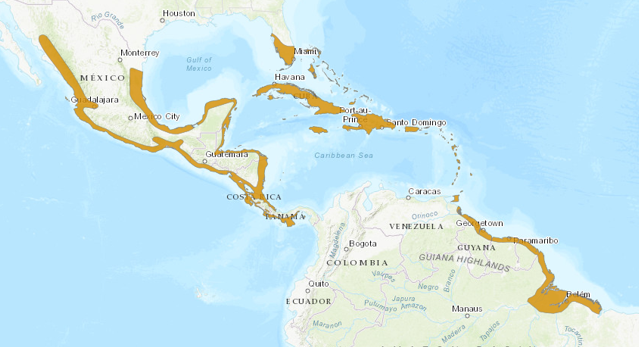Birdfinding.info ⇒ Locally common in several parts of Middle America and the West Indies—e.g., dry forest sites on Puerto Rico, Vieques, and the Virgin Islands. Uncommon in Florida: upper Key Largo is consistent, especially around April when they call frequently. Other perennial sites include the Biscayne National Park visitor center, Sugarloaf and Saddlebunch Keys, and Ding Darling National Wildlife Refuge.
Mangrove Cuckoo
Coccyzus minor
Middle America, southern Florida, the West Indies, and northeastern South America. Inhabits various types of woodland, including mangroves, dry forest, and scrub.
In Middle America, found mainly in coastal lowlands from southern Sonora and southern Tamaulipas to central Panama. Also occurs in some interior valleys from southern Mexico southward.
Occurs nearly throughout the West Indies from Grand Bahama to Trinidad, but very localized in Cuba (mainly on the northern cays).
In Florida, very localized in mangroves and adjacent woodlands from Tampa Bay and Miami to the Keys.
In northern South America, local in coastal mangroves from the Orinoco Delta to Ceará.
Movements. Mostly resident, but somewhat dispersive. Occurs fairly often as a vagrant to the ABC Islands and northern Colombia. There are several records along the Gulf Coast from Texas to the Florida Panhandle, and one exceptional record from Quebec.
Identification
Grayish-brown above, buffy below, with a pronounced blackish mask, and bicolored, black-over-yellow bill.
The three outer tail feathers are graduated in length and broadly tipped with white—usually visible only from below as six large white spots on a black background.
The tones, intensity and extent of the buffy coloration vary widely. Most are some shade of buff throughout the underparts, but the palest individuals have a whitish throat and chest, and the more colorful verge on yellow, orange, or rufous—usually richest on the lower breast and belly.

Mangrove Cuckoo. (Barrio Naranjo, Comerío, Puerto Rico; April 2, 2013.) © Ernesto Burgos

Mangrove Cuckoo, a distinctly yellow individual. (San Blas, Nayarit, Mexico; March 27, 2018.) © Jason Vassallo
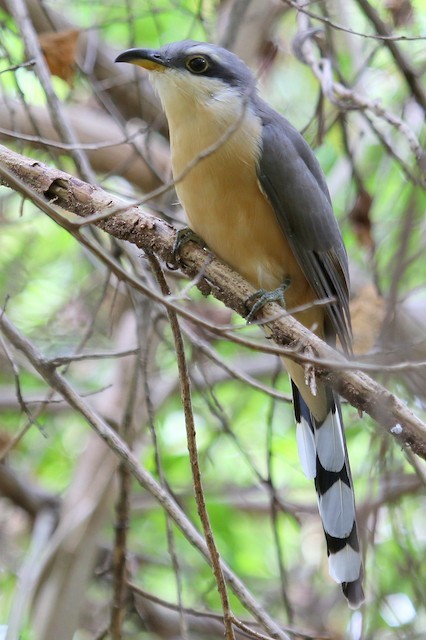
Mangrove Cuckoo. (Punta Nizuc, Quintana Roo, Mexico; November 23, 2016.) © Steve Rottenborn

Mangrove Cuckoo, with unusually rufous underparts. (Laguna Cartagena National Wildlife Refuge, Cayey, Puerto Rico; March 26, 2013.) © Eric Hynes
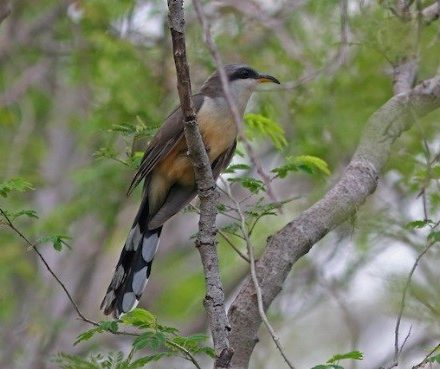
Mangrove Cuckoo, showing unusually pale white throat. (Guánica State Forest, Puerto Rico; June 4, 2006.) © David Disher

Mangrove Cuckoo. (Finca Tamashan, Retalhuleu, Guatemala; March 12, 2018.) © Oliver Komar

Mangrove Cuckoo. (Cozumel, Mexico; June 30, 2018.) © Patrick V.

Mangrove Cuckoo. (Monte Pirata, Vieques; January 10, 2016.) © Christoph Moning

Mangrove Cuckoo. (Rancho Vegas, Cayey, Puerto Rico; November 24, 2016.) © José Santiago
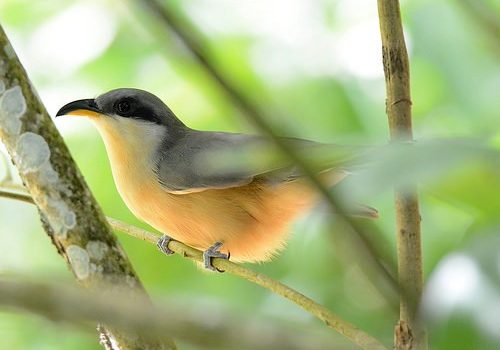
Mangrove Cuckoo, an orange-buff individual. (Des Barras Road, Dauphin, St. Lucia; November 26, 2015.) © Kyle Kittelberger
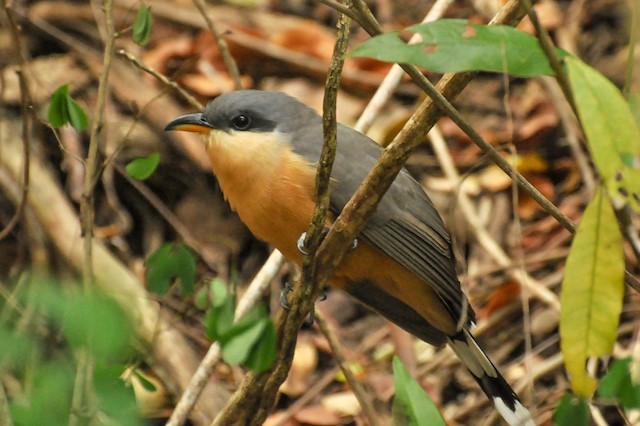
Mangrove Cuckoo, a rich orange individual. (Marigot Bay, St. Lucia; February 16, 2016.) © Ryan Doherty

Mangrove Cuckoo, with creamy-white underparts. (Visitor Center, Biscayne National Park, Florida; April 25, 2017.) © Alan Mayo
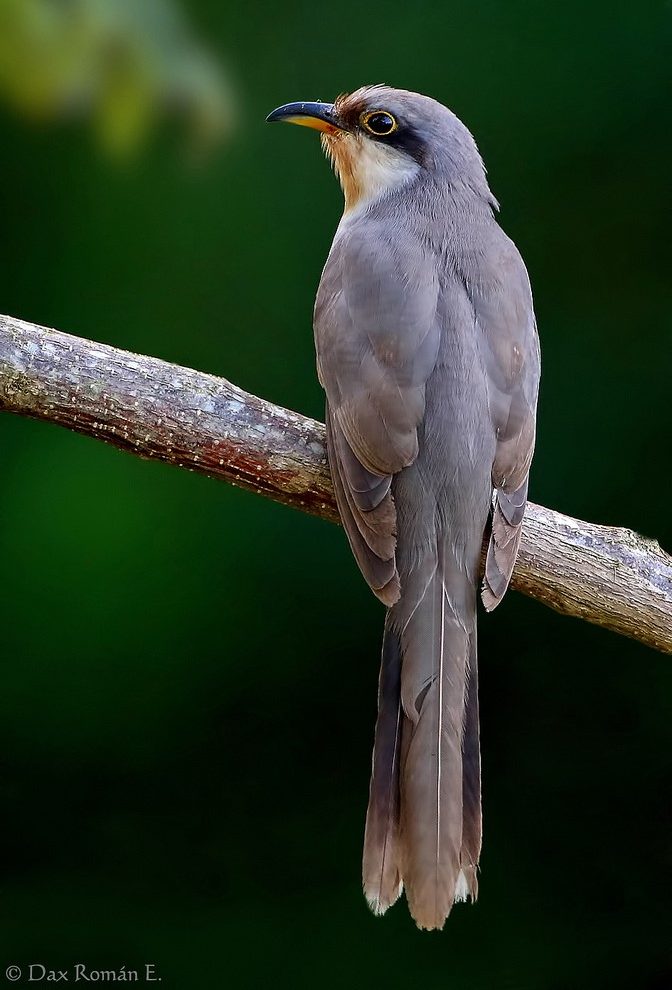
Mangrove Cuckoo. (Lomas Lindas, Dominican Republic; January 6, 2014.) © Dax M. Román E.
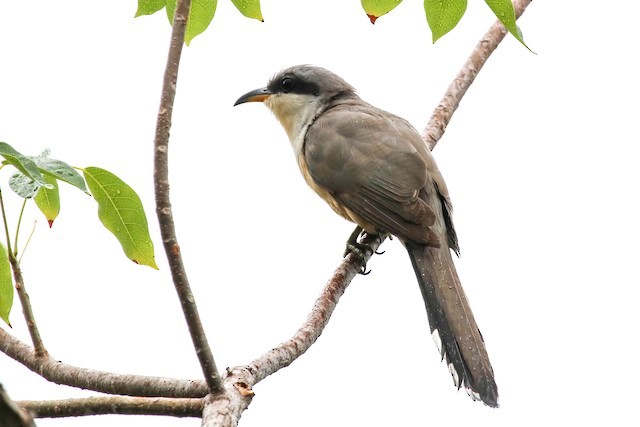
Mangrove Cuckoo. (Labadie, Haiti; March 16, 2018.) © Graham Williams
Cf. Yellow-billed and Pearly-breasted Cuckoos. Yellow-billed, Pearly-breasted, and Mangrove Cuckoos all have approximately the same bill color and tail pattern. Yellow-billed occurs throughout Mangrove’s range and Pearly-breasted overlaps with Mangrove in South America.
Mangrove’s buffy underparts are usually distinctive, but variable. Its blackish mask is usually darker and more extensive than the subtler masks of Yellow-billed and Pearly-breasted. Yellow-billed can often be identified in flight by the rufous flash in its wings—which both Mangrove and Pearly-breasted lack.
Cf. Dark-billed Cuckoo. The South American Dark-billed Cuckoo strongly resembles Mangrove in most aspects of its plumage, but has an all-black bill and smaller white spots on the undertail.
Notes
Monotypic species.
Mangrove Cuckoo Florida Breeding Bird Survey Map.
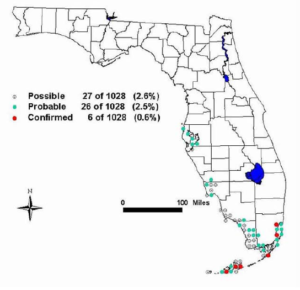
References
Alderfer, J., and J.L. Dunn. 2014. National Geographic Complete Birds of North America (Second Edition). National Geographic Society, Washington, D.C.
Ascanio, D., G.A. Rodriguez, and R. Restall. 2017. Birds of Venezuela. Christopher Helm, London.
eBird. 2018. eBird: An online database of bird distribution and abundance. Cornell Lab of Ornithology, Ithaca, N.Y. http://www.ebird.org. (Accessed December 26, 2018.)
Erritzøe, J., C.F. Mann, F.P. Brammer, and R.A. Fuller. 2012. Cuckoos of the World. Christopher Helm, London.
Fagan, J., and O. Komar. 2016. Peterson Field Guide to the Birds of Northern Central America. Houghton Mifflin Harcourt, New York.
ffrench, R. 2012. A Guide to the Birds of Trinidad & Tobago (Third Edition). Cornell University Press, Ithaca, N.Y.
Florida Fish and Wildlife Conservation Commission. 2003. Florida’s breeding bird atlas: A collaborative study of Florida’s birdlife. http://www.myfwc.com/bba/.
Garrigues, R., and R. Dean. 2014. The Birds of Costa Rica: A Field Guide (Second Edition). Cornell University Press, Ithaca, N.Y.
Garrido, O.H, and A. Kirkconnell. 2000. Field Guide to the Birds of Cuba. Cornell University Press, Ithaca, N.Y.
Gemmill, D. 2015. Birds of Vieques Island, Puerto Rico: Status, Abundance, and Conservation. Special issue of The Journal of Caribbean Ornithology, BirdsCaribbean, Scholarly & Specialized Publishing, Charlottesville, Virginia.
Haynes-Sutton, A., A. Downer, R. Sutton, and Y.-J. Rey-Millet. 2009. A Photographic Guide to the Birds of Jamaica. Princeton University Press, Princeton, N.J.
Howell, S.N.G., and S. Webb. 1995. A Guide to the Birds of Mexico and Northern Central America. Oxford University Press, Oxford.
Latta, S., C. Rimmer, A. Keith, J. Wiley, H. Raffaele, K. McFarland, and E. Fernandez. 2006. Birds of the Dominican Republic and Haiti. Princeton University Press, Princeton, N.J.
McMullan, M., and T. Donegan. 2014, Field Guide to the Birds of Colombia (Second Edition). Fundación Proaves de Colombia, Bogotá.
Raffaele, H., J. Wiley, O. Garrido, A. Keith, and J. Raffaele. 1998. A Guide to the Birds of the West Indies. Princeton University Press, Princeton, N.J.
Ridgely, R.S., and J.A. Gwynne. 1989. A Guide to the Birds of Panama (Second Edition). Princeton University Press, Princeton, N.J.
Wikiaves, Papa-lagarta-do-mangue, http://www.wikiaves.com.br/papa-lagarta-do-mangue.

